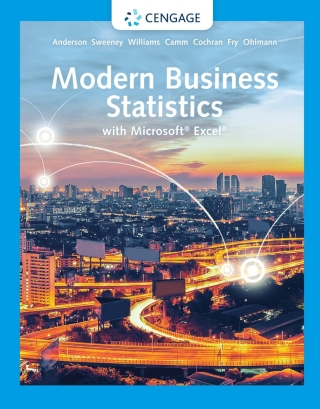Buy Modern Business Statistics with Microsoft Excel, 7th Edition PDF ebook by author David R. Anderson; Dennis J. Sweeney; Thomas A. Williams – published by Cengage Learning in 2021 and save up to 80% compared to the print version of this textbook. With PDF version of this textbook, not only save you money, you can also highlight, add text, underline add post-it notes, bookmarks to pages, instantly search for the major terms or chapter titles, etc.
You can search our site for other versions of the Modern Business Statistics with Microsoft Excel, 7th Edition PDF ebook. You can also search for others PDF ebooks from publisher Cengage Learning, as well as from your favorite authors. We have thousands of online textbooks and course materials (mostly in PDF) that you can download immediately after purchase.
Note: e-textBooks do not come with access codes, CDs/DVDs, workbooks, and other supplemental items.
eBook Details:
Full title: Modern Business Statistics with Microsoft Excel, 7th Edition
Edition: 7th
Copyright year: 2021
Publisher: Cengage Learning
Author: David R. Anderson; Dennis J. Sweeney; Thomas A. Williams
ISBN: 9780357131657, 9780357131527
Format: PDF
Description of Modern Business Statistics with Microsoft Excel, 7th Edition:
Develop a strong conceptual understanding of statistics and its importance in business today with MODERN BUSINESS STATISTICS WITH MICROSOFT EXCEL, 7E. This best-selling, comprehensive edition balances real-world applications with an integrated focus on the latest version of Microsoft Excel. A clear presentation develops each statistical technique in an application setting. You master statistical methodology as each easy-to-follow explanation of a statistical procedure is followed by a discussion of how to use the latest Excel to perform the procedure. Step-by-step instructions and screen images reinforce understanding. For versatility, you also learn to use Excel Online and R. More than 160 new business examples, proven methods, and application exercises show how statistics provide insights into business decisions and problems. A unique problem-scenario approach emphasizes how to apply statistical methods to practical business situations, while new case problems let you check your understanding.Important Notice: Media content referenced within the product description or the product text may not be available in the ebook version.
Table of Contents of Modern Business Statistics with Microsoft Excel, 7th Edition PDF ebook:
Brief ContentsContentsPrefaceAbout the AuthorsChapter 1: Data and Statistics1.1 Applications in Business and Economics1.2 Data1.3 Data Sources1.4 Descriptive Statistics1.5 Statistical Inference1.6 Statistical Analysis Using Microsoft Excel1.7 Analytics1.8 Big Data and Data Mining1.9 Ethical Guidelines for Statistical PracticeSummaryGlossarySupplementary ExercisesChapter 2: Descriptive Statistics: Tabular and Graphical Displays2.1 Summarizing Data for a Categorical Variable2.2 Summarizing Data for a Quantitative Variable2.3 Summarizing Data for Two Variables Using Tables2.4 Summarizing Data for Two Variables Using Graphical Displays2.5 Data Visualization: Best Practices in Creating Effective Graphical DisplaysSummaryGlossaryKey FormulasSupplementary ExercisesCase Problem 1: Pelican StoresCase Problem 2: Movie Theater ReleasesCase Problem 3: Queen CityCase Problem 4: Cut-Rate Machining, Inc.Chapter 3: Descriptive Statistics: Numerical Measures3.1 Measures of Location3.2 Measures of Variability3.3 Measures of Distribution Shape, Relative Location, and Detecting Outliers3.4 Five-Number Summaries and Boxplots3.5 Measures of Association between Two Variables3.6 Data Dashboards: Adding Numerical Measures to Improve EffectivenessSummaryGlossary Key Formulas Supplementary ExercisesCase Problem 1: Pelican StoresCase Problem 2: Movie Theater ReleasesCase Problem 3: Business Schools of Asia-PacificCase Problem 4: Heavenly Chocolates Website TransactionsCase Problem 5: African Elephant PopulationsChapter 4: Introduction to Probability4.1 Experiments, Counting Rules, and Assigning Probabilities4.2 Events and Their Probabilities4.3 Some Basic Relationships of Probability4.4 Conditional Probability4.5 Bayes’ TheoremSummaryGlossaryKey FormulasSupplementary ExercisesCase Problem 1: Hamilton County JudgesCase Problem 2: Rob’s MarketChapter 5: Discrete Probability Distributions5.1 Random Variables5.2 Developing Discrete Probability Distributions5.3 Expected Value and Variance5.4 Bivariate Distributions, Covariance, and Financial Portfolios5.5 Binomial Probability Distribution5.6 Poisson Probability Distribution5.7 Hypergeometric Probability DistributionSummaryGlossaryKey FormulasSupplementary ExercisesCase Problem 1: Go Bananas! Breakfast CerealCase Problem 2: McNeil’s Auto MallCase Problem 3: Grievance Committee at Tuglar CorporationCase Problem 4: Sagittarius CasinoChapter 6: Continuous Probability Distributions6.1 Uniform Probability Distribution6.2 Normal Probability Distribution6.3 Exponential Probability DistributionSummaryGlossaryKey FormulasSupplementary ExercisesCase Problem 1: Specialty ToysCase Problem 2: Gebhardt ElectronicsChapter 7: Sampling and Sampling Distributions7.1 The Electronics Associates Sampling Problem7.2 Selecting a Sample7.3 Point Estimation7.4 Introduction to Sampling Distributions7.5 Sampling Distribution of x7.6 Sampling Distribution of p7.7 Other Sampling Methods7.8 Practical Advice: Big Data and Errors in SamplingSummaryGlossaryKey FormulasSupplementary ExercisesCase Problem: Marion DairiesChapter 8: Interval Estimation8.1 Population Mean: o Known8.2 Population Mean: o Unknown8.3 Determining the Sample Size8.4 Population Proportion8.5 Practical Advice: Big Data and Interval EstimationSummaryGlossaryKey FormulasSupplementary ExercisesCase Problem 1: Young Professional MagazineCase Problem 2: GULF Real Estate PropertiesCase Problem 3: Metropolitan Research, Inc.Chapter 9: Hypothesis Tests9.1 Developing Null and Alternative Hypotheses9.2 Type I and Type II Errors9.3 Population Mean: o Known9.4 Population Mean: o Unknown9.5 Population Proportion9.6 Practical Advice: Big Data and Hypothesis TestingSummaryGlossaryKey FormulasSupplementary ExercisesCase Problem 1: Quality Associates, Inc.Case Problem 2: Ethical Behavior of Business Students at Bayview UniversityChapter 10: Inference about Means and Proportions with Two Populations10.1 Inferences about the Difference between Two Population Means: o1 and o2 Known10.2 Inferences about the Difference between Two Population Means: o1 and o2 Unknown10.3 Inferences about the Difference between Two Population Means: Matched Samples10.4 Inferences about the Difference between Two Population ProportionsSummaryGlossaryKey FormulasSupplementary ExercisesCase Problem: Par, Inc.Chapter 11: Inferences about Population Variances11.1 Inferences about a Population Variance11.2 Inferences about Two Population VariancesSummaryKey FormulasSupplementary ExercisesCase Problem 1: Air Force Training ProgramCase Problem 2: Meticulous Drill & ReamerChapter 12: Tests of Goodness of Fit, Independence, and Multiple Proportions12.1 Goodness of Fit Test12.2 Test of Independence12.3 Testing for Equality of Three or More Population ProportionsSummaryGlossaryKey FormulasSupplementary ExercisesCase Problem 1: A Bipartisan Agenda for ChangeCase Problem 2: Fuentes Salty Snacks, Inc.Case Problem 3: Fresno Board GamesChapter 13: Experimental Design and Analysis of Variance13.1 An Introduction to Experimental Design and Analysis of Variance13.2 Analysis of Variance and the Completely Randomized Design13.3 Multiple Comparison Procedures13.4 Randomized Block Design13.5 Factorial ExperimentSummaryGlossaryKey FormulasSupplementary ExercisesCase Problem 1: Wentworth Medical CenterCase Problem 2: Compensation for Sales ProfessionalsCase Problem 3: TourisTopia TravelChapter 14: Simple Linear Regression14.1 Simple Linear Regression Model14.2 Least Squares Method14.3 Coefficient of Determination14.4 Model Assumptions14.5 Testing for Significance14.6 Using the Estimated Regression Equation for Estimation and Prediction14.7 Excel’s Regression Tool14.8 Residual Analysis: Validating Model Assumptions14.9 Outliers and Influential Observations14.10 Practical Advice: Big Data and Hypothesis Testing in Simple Linear RegressionSummaryGlossaryKey FormulasSupplementary ExercisesCase Problem 1: Measuring Stock Market RiskCase Problem 2: U.S. Department of TransportationCase Problem 3: Selecting a Point-and-Shoot Digital CameraCase Problem 4: Finding the Best Car ValueCase Problem 5: Buckeye Creek Amusement ParkAppendix 14.1: Calculus-Based Derivation of Least Squares FormulasAppendix 14.2: A Test for Significance Using CorrelationChapter 15: Multiple Regression15.1 Multiple Regression Model15.2 Least Squares Method15.3 Multiple Coefficient of Determination15.4 Model Assumptions15.5 Testing for Significance15.6 Using the Estimated Regression Equation for Estimation and Prediction15.7 Categorical Independent Variables15.8 Residual Analysis15.9 Practical Advice: Big Data and Hypothesis Testing in Multiple RegressionSummaryGlossaryKey FormulasSupplementary ExercisesCase Problem 1: Consumer Research, Inc.Case Problem 2: Predicting Winnings for NASCAR DriversCase Problem 3: Finding the Best Car ValueChapter 16: Regression Analysis: Model Building16.1 General Linear Model16.2 Determining When to Add or Delete Variables16.3 Analysis of a Larger Problem16.4 Variable Selection Procedures16.5 Multiple Regression Approach to Experimental Design16.6 Autocorrelation and the Durbin-Watson TestSummaryGlossaryKey FormulasSupplementary ExercisesCase Problem 1: Analysis of LPGA Tour StatisticsCase Problem 2: Rating Wines from the Piedmont Region of ItalyChapter 17: Time Series Analysis and Forecasting17.1 Time Series Patterns17.2 Forecast Accuracy17.3 Moving Averages and Exponential Smoothing17.4 Trend Projection17.5 Seasonality and Trend17.6 Time Series DecompositionSummaryGlossaryKey FormulasSupplementary ExercisesCase Problem 1: Forecasting Food and Beverage SalesCase Problem 2: Forecasting Lost SalesChapter 18: Nonparametric Methods18.1 Sign Test18.2 Wilcoxon Signed-Rank Test18.3 Mann-Whitney-Wilcoxon Test18.4 Kruskal-Wallis Test18.5 Rank CorrelationSummaryGlossaryKey FormulasSupplementary ExercisesCase: RainOrShine.ComChapter 19: Statistical Methods for Quality Control19.1 Philosophies and Frameworks19.2 Statistical Process Control19.3 Acceptance SamplingSummaryGlossaryKey FormulasSupplementary ExercisesChapter 20: Decision Analysis20.1 Problem Formulation20.2 Decision Making with Probabilities20.3 Decision Analysis with Sample Information20.4 Computing Branch Probabilities Using Bayes’ TheoremSummaryGlossaryKey FormulasSupplementary ExercisesCase Problem 1: Lawsuit Defense StrategyCase Problem 2: Property Purchase StrategyAppendixesAppendix A: References and BibliographyAppendix B: TablesAppendix C: Summation NotationAppendix E: Microsoft Excel and Tools for Statistical AnalysisAppendix F: Microsoft Excel Online and Tools for Statistical AnalysisIndex





